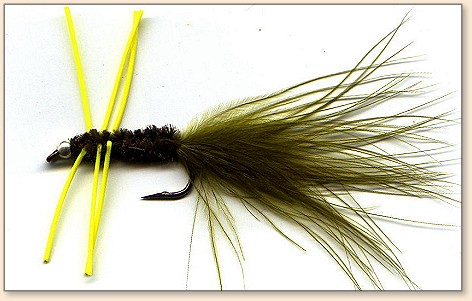|
We have had rain coming out of our ears for
the past couple of weeks. I went out to the
lake over my lunch hour and the water level
was up. The lake had come up almost 18 inches
in the past two weeks. I had lost several flies
the previous week when I had hooked big fish but
could not see them. They would take me down to
the bottom and break off on the rocks or would
take out so much line that the 6 X tippet could
not take the strain.
I came prepared this time. I had a spool of 1X
with me and had one pole rigged up with that for
the leader. I thought this might give me a better
chance to see what I was tangling with. I left
the other pole with the 6X tippet on it.
There is a settling pond on the east side of the
road in the area where I normally fish. I decided
to fish the area where this was dumping into the
lake. The area where it dumps into the lake has
a large pile of rock that extends out about 20
feet and is about 20 feet wide also. This was put
in so that any drainage water would not damage the
roadbed (this is the story from the engineer).
The wind was coming from the north and the water
coming out of the settling pond was being moved
to the south along the bank. The dirty water
plume started out about 8 feet wide and went to
twenty feet by the time it hit the end of the
little bay formed by the road and the one fishing
jetty.

I decided to tie on a fly that I have been playing
with. I tie it on a size 6 hook. Olive marabou for
the tail. The body is olive chenille. Toward the
front tie in three pieces of rubber hackle across
the hook to form legs, about one inch long on each
side. I let the chenille separate these legs as I
tie them closely together. I do not use any hackle
to palmer the body on this fly. I usually put a
bead head on it also. (I have tied this fly in
black on a size 10 hook and done well on gills.)
I set up about 20 feet down wind of the culvert and
made my first cast. I put in fairly close to where
the culvert dumps the water into the lake. The fly
had barely started to drop when the line twitched
and I sat the hook. The fish immediately took off
for parts unknown. The first run did not stop until
I was about 50 yards into the backing. I slowly
managed to gain some line as the fish moved around
out in the lake. I finally managed to get the fish
within about 20 feet of the shore and that was close
enough for the fish and she headed out again. This
run was a little shorter. We did this three times
before I thought that I might have some control over
the fish.
By this time, I had gained an audience. One guy told
me that he had a net. I finally got the fish up where
I could see it, a good size carp. Now it came into a
tug-of-war. I would pull the fish in and she would
swim out a few feet. After a 15 to 20 minute battle
I got her in close enough to be netted. She was 23
inches long. I am not sure how much she weighed.
One of the people there wanted her to smoke, so I
gave her up.
The one thing I had done was to move about 30 feet
farther away from the culvert during this fight.
I thought there might be another fish around the
culvert. I moved back up to where I had been and
made another cast. The fly had dropped about a
foot or so and I was starting to retrieve it when
another fish hit it hard. This fish came in faster.
I was able to control it a little better. This was
another carp, about 14" long. This one also headed
to the smoke house.
I have a feeling that I was hooking carp before,
but was not equipped to fight them. I moved back
up the shore to cast again. My great casting
ability came into play now and this cast landed
about 10 feet out from the culvert. I decided that
I would retrieve it very slowly and see if anything
was out there. The fly had come to near the edge
of the rock pile and there was a solid thunk. I
had a crappie that was almost a foot long. This
is a rarity in this lake.
One person told me that they would lend me a bucket
if I wanted to keep this fish. I decided to do that.
My next cast into the area resulted in a nice gill
hitting the fly. I was fishing the fly down about
2 to 3 feet in the water and as it came near the
edge of the rock pile the fish would hit it.
By casting out from the culvert I managed to land
a couple of more nice crappie. I made a cast that
fell short of where I wanted it to go and it was
just barely off the shore,. This happens more than
I will admit. I had not got the line straightened
out before it was going side ways. I had a foot
long bass that had inhaled the fly. I had to use
forceps to get it out.
I decided to make one more cast before heading
back into work. I let the fly drop a little
deeper than I had before and was doing a very
slow retrieve. I felt some weight on the line
and set the hook. This fish went deep and
twisted around. I managed to get it up from
the bottom and let it swim around some to wear
off some energy. When I could get it up I saw
that I had a small channel cat. I got this fish
into shore and put it into the bucket. I knew
what I was having for supper.
Time had run out and I needed to head back to
the office. I was going to keep the crappies
and the cat in the bucket, with water, and
take them home. The gentleman who I had given
the carp told me that I wanted him to he would
fillet them and bring the fillets to my office.
I took him up on the offer.
I went home and had a nice mess of fish for supper.
So I caught five species of fish from one small
area using one fly. I had a good time doing this.
Hope you can get out on the water. ~ Rick ziegeria@grm.net
|





